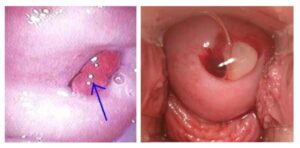Cervical polyps are growths that develop from the stromal tissue of the cervix and are covered by epithelium, originating from the cervical canal. They can be pedunculated or non-pedunculated, with sizes varying from a few mm to several cm, and are often found in women who have given birth multiple times. So, how does the procedure for cauterizing cervical polyps take place?
1. Indications for Treatment
Patients with cervical polyps typically do not have symptoms but may experience increased vaginal discharge, intermenstrual bleeding, or bleeding after intercourse. Cervical polyps are usually benign, but about 1% of cases may undergo malignant transformation.
Indications for treatment when:
- The cervical polyp is large.
- The cervical polyp is symptomatic: increased vaginal discharge, intermenstrual bleeding, bleeding after intercourse.
2. Preparation Before Cauterization
Cervical cytology/pathology tests to rule out precancerous/cancerous lesions.
3. Steps for Cauterizing Polyps
- Step 1: Disinfect the vagina, expose the cervix, and identify the base of the polyp: pedunculated, non-pedunculated, originating from the cervical os or the cervical canal.
- Step 2: Use a heart-shaped clamp to grasp the polyp and twist around the stalk until it breaks. If the polyp is large and non-pedunculated, an electrosurgical knife should be used to remove it at the base.
- Step 3: Apply Monsel’s solution and compress at the stalk/cut surface to achieve hemostasis. Use an electrosurgical knife to cauterize for hemostasis. Vaginal packing may be used to control bleeding.
- Step 4. Disinfect the vagina. Send the specimen for histopathological examination.
4. Follow-up after coagulation
Monitor for bleeding from the site of the polyp excision/coagulation for 4-6 hours (home monitoring instructions).

5. Management:
Bleeding at the base of the polyp: apply Monsel’s solution, cauterize the bleeding point, suture for hemostasis – Suture two vaginal cervical arteries: two sutures at the 9 and 3 o’clock positions if there is significant bleeding; if bleeding does not stop, a hysterectomy may be necessary.

